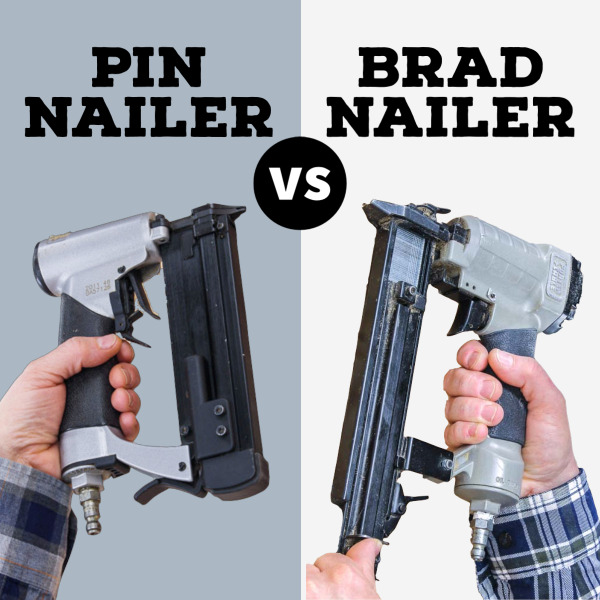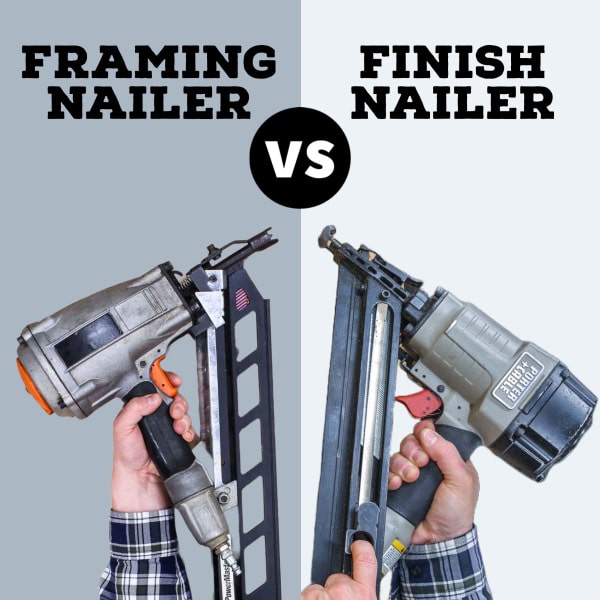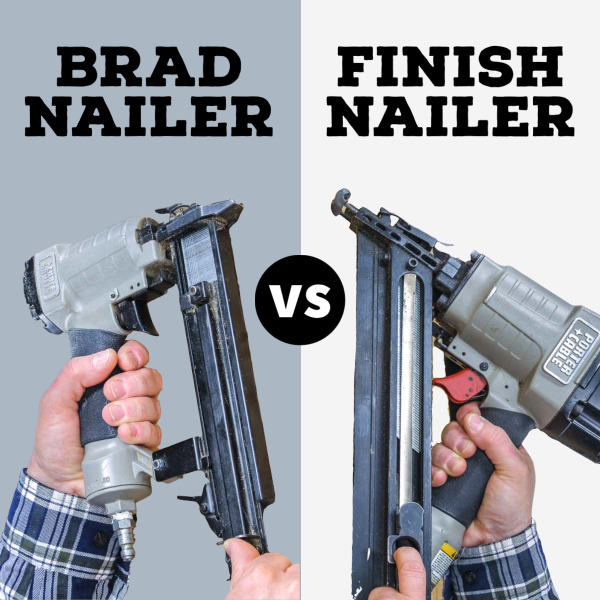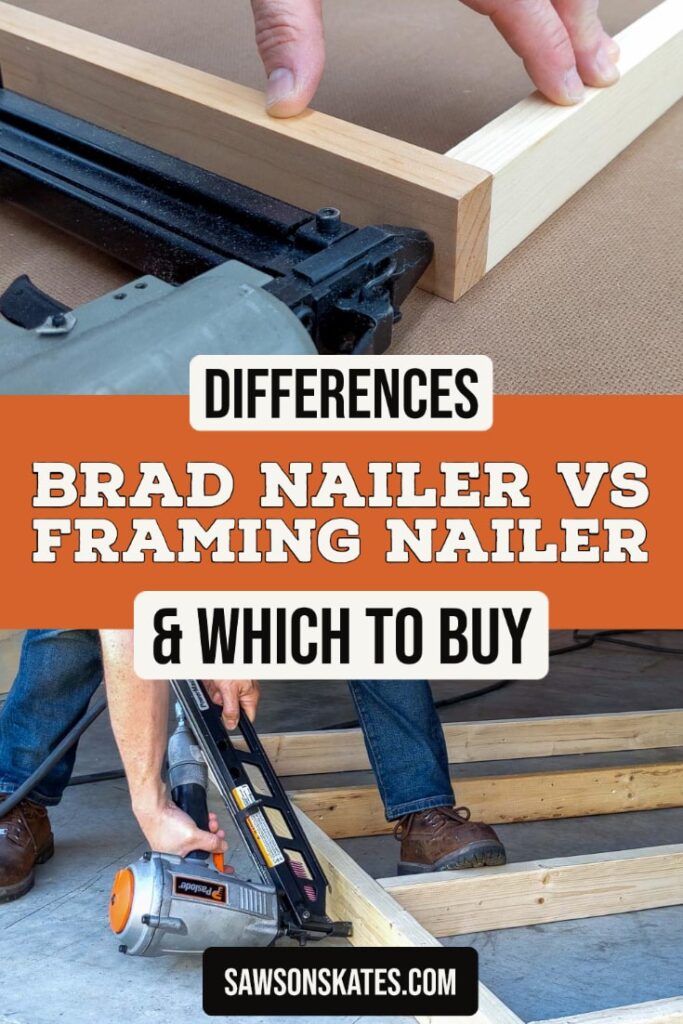Brad Nailer vs Framing Nailer (Differences + Which to Buy)
Trying to decide between a framing nailer and a brad nailer? Learn the differences and which is right for you in this side-by-side comparison.
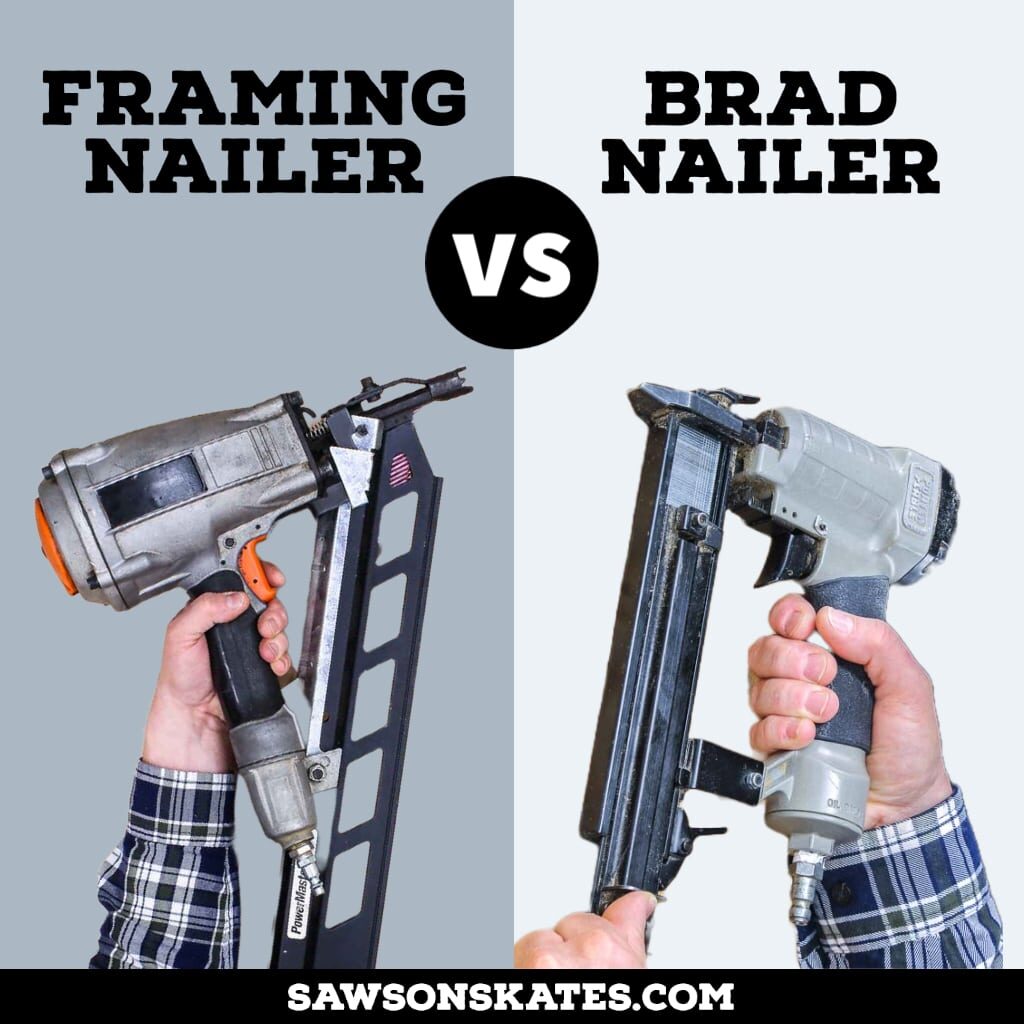
When it’s time to tackle a DIY project, you need the right tools for the job, but you may be wondering if you need a brad nailer or a framing nailer? What’s the difference between these tools? And when should you use each one? In this article, we’ll look at both types of nailers and help you decide which is the best tool for your needs.
This tutorial contains affiliate links to supplies and tools. Purchases made using these links help support the Saws on Skates website and allows me to share more projects and tips with you. There is no cost to you for using these links. Visit my site policies for more information.
Table of Contents
- What is a Framing Nailer?
- What are Framing Nailers Used For?
- Framing Nailer Pros and Cons
- What is a Brad Nailer?
- What are Brad Nailers Used For?
- Brad Nailer Pros and Cons
- What’s the Difference Between a Framing Nailer and a Brad Nailer?
- Should I Buy a Framing Nailer or Brad Nailer?
- More Nailer Considerations
- Nailer Safety
- Frequently Asked Questions
What is a Framing Nailer?
A framing nailer is a powerful tool used for driving large nails into thick construction materials. It uses 8-gauge to 12-gauge nails with diameters ranging from 0.113 to 0.162 inches and lengths ranging from 1-¼ inches to 3-½ inches.
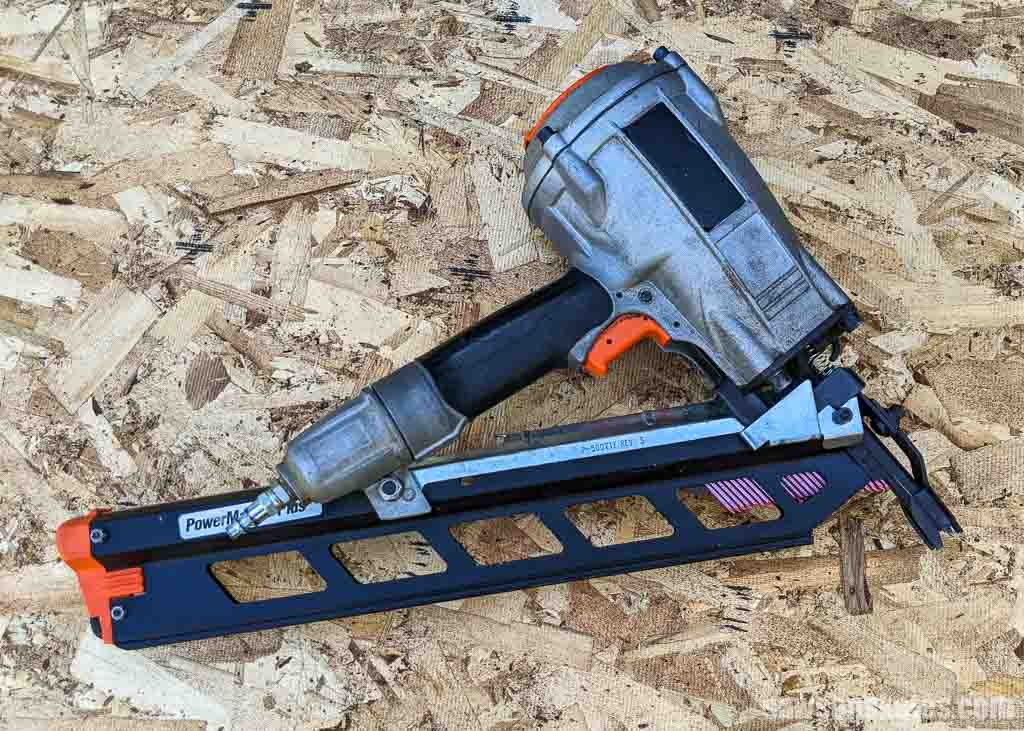
A nail’s gauge is the number of nails that fit within an inch. The smaller a nail is, the higher its gauge. For example, with a 12-gauge nail, you can fit 12 nails per inch, but only 8 per inch with bigger 8-gauge nails.
Related: How to Use a Tape Measure Correctly (Tips for Success)
The three most common types of nail heads used in framing nailers are:
- Full round head: round head centered over the shank.
- Offset round head: head offset to one side of the shank.
- Clipped head: semi-circle head offset to one side of the shank.
💡 TIP: The type of nail head used for construction projects varies by area. Always check with your local building code authorities to see what is allowed in your region.
What are Framing Nailers Used For?
A framing nailer is often used for home building and large construction projects. It’s known as a framing nailer because it’s frequently used for framing, which is the process of building walls, floors, and a roof in a house.

Framing nails have tremendous holding power, making them an excellent choice for jobs that require strength, such as connecting 2×4s, beams, and other large pieces of construction lumber.
Related: Beginners Guide to Wood Sizes
Framing nailers are a popular tool among professional carpenters and DIYers doing major home construction projects or renovations.
Framing nailers are used for building projects such as:
- Homebuilding
- Room additions
- Building a garage or shed
- Attaching roof sheathing
- Building a deck
- Building fences
When selecting a nailer, it is critical to get one that uses nails appropriate for the material you will be working with.
A framing nailer is an excellent tool for heavy-duty work, but it might be too powerful for some light-duty tasks. Because the nails used in a framing nailer are big, there’s a greater chance of splitting smaller pieces of wood. As a result, you shouldn’t use a framing nailer to install thin, narrow molding.
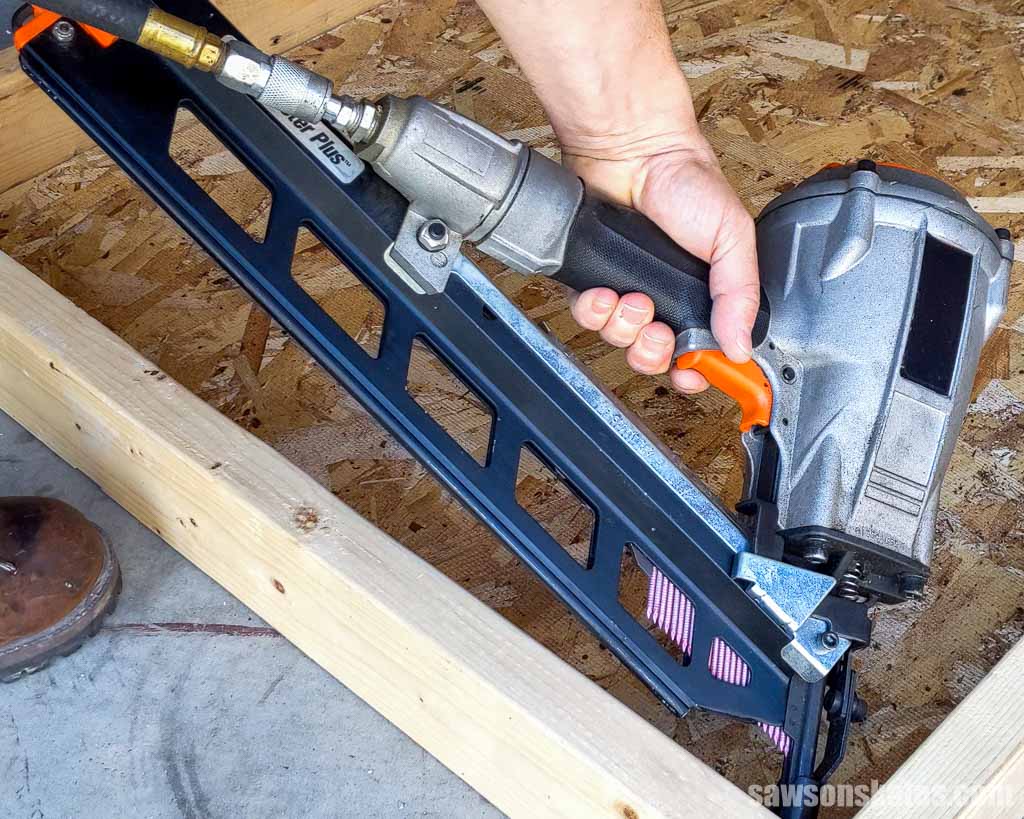
Framing Nailer Pros and Cons
Pros
- Quicker and more efficient than a hammer
- Incredible power and holding strength
- Ideal for a variety of heavy-duty building projects
- 3 nail head options
Cons
- Too powerful for some light-duty projects
- Large diameter nails may crack small pieces of wood
What is a Brad Nailer?
A brad nailer is a tool used to attach lightweight materials using small nails, called brads. Brads are wire-like, 18-gauge nails with a t-shaped head. Brad nails are typically 0.0403-inches in diameter and range in length from ⅜ inches to 2 inches.
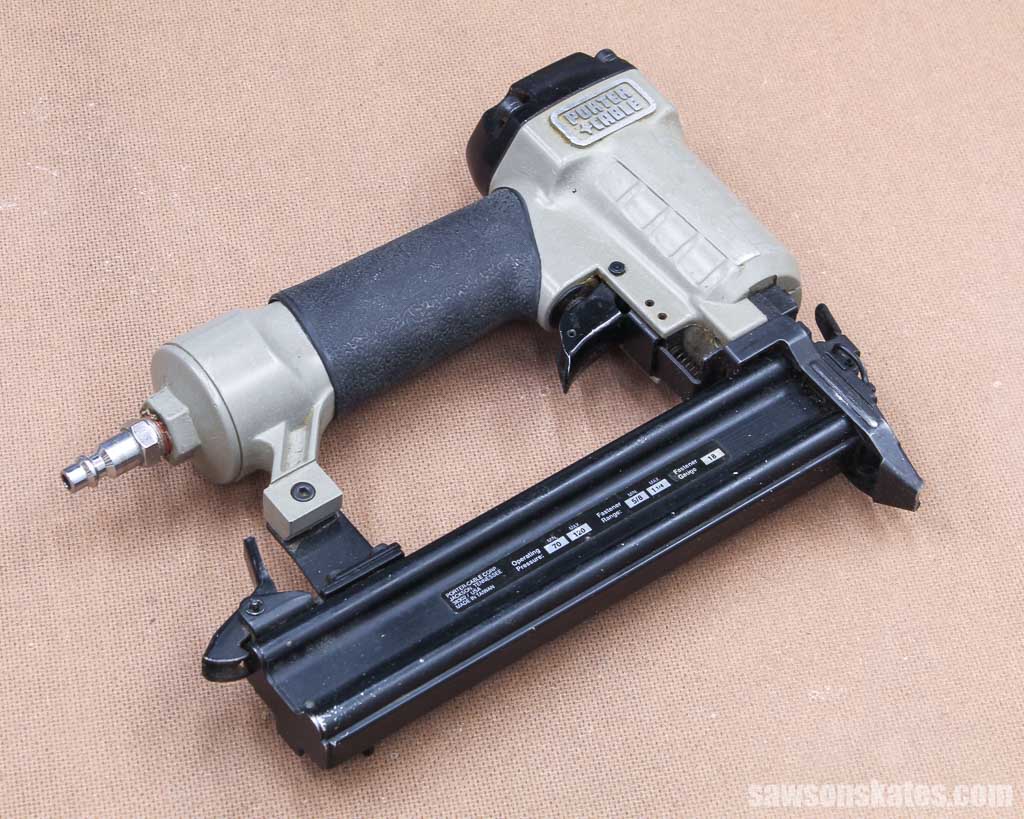
What are Brad Nailers Used For?
Brad nailers are most often used for finish carpentry which is the process of adding the final touches to a construction project. This includes tasks such as installing baseboards, door and window casings, crown molding, and other decorative trim.
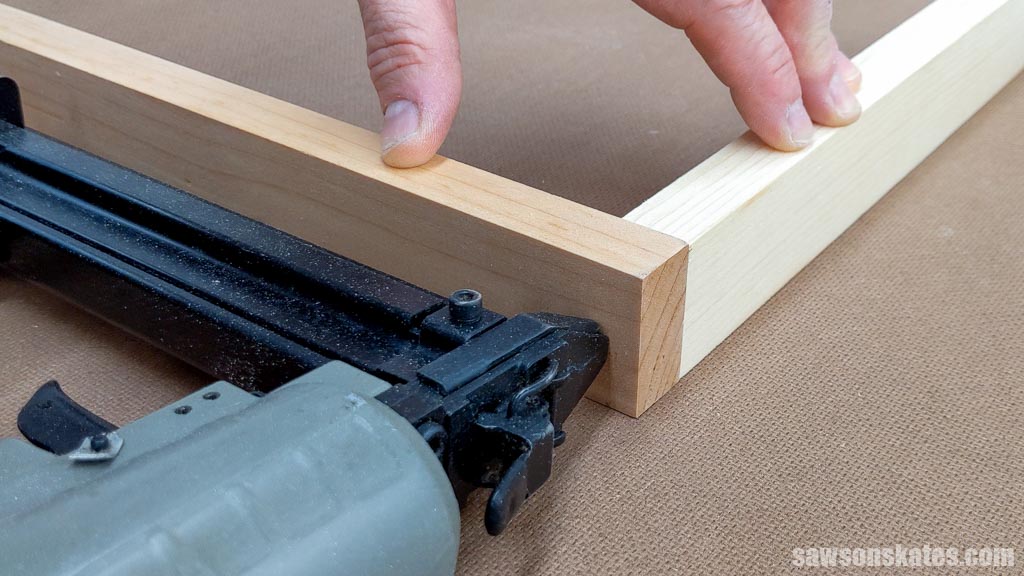
Brad nailers are sometimes referred to as finish nailers; however, a finish nailer is a different tool that uses either 15-gauge or 16-gauge nails.
Related: Brad Nailer vs Finish Nailer (Which to Choose & Why)
Brad nails have the strength to hold lightweight trim in place, but they lack the power to support heavy moldings and join construction lumber such as 2×4s. They also have a difficulty penetrating hardwoods, MDF, and thick plywood.
Instead, brad nailers are used for finish carpentry projects such as:
- Cabinet and DIY furniture trim
- Decorative molding
- Shoe molding, quarter round, and door stop molding
The advantage of using a brad nailer to attach these materials is the small nails are less likely to split the wood. The smaller nails are also easier to hide with wood filler and blend in with the surface of the wood, making them virtually invisible.
Related: Wood Putty vs Wood Filler (Which to Use & Why)
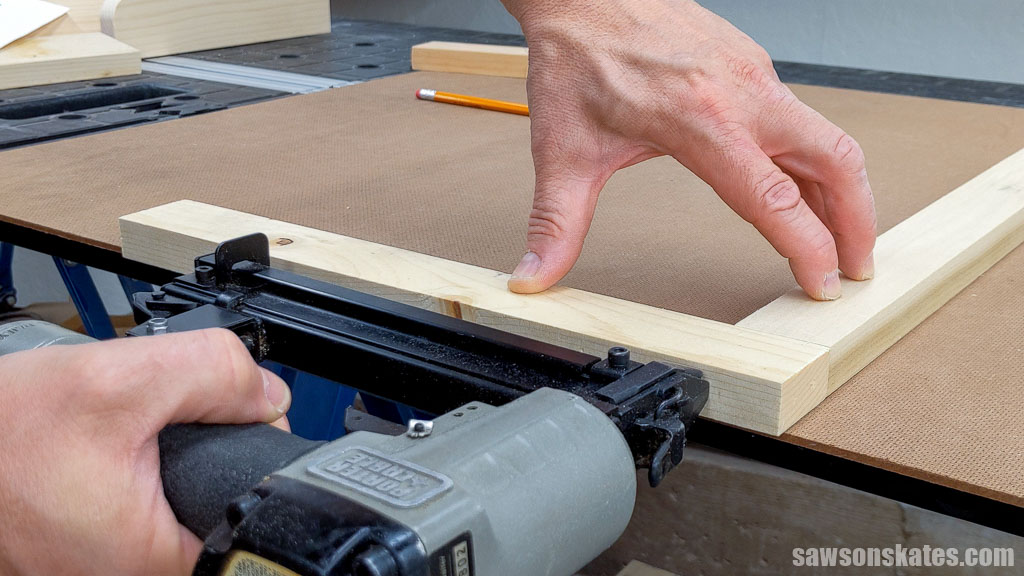
Brad Nailer Pros and Cons
Pros
- Ideal for lightweight finish carpentry projects
- Small nails are less likely to split wood
- Nails are easy to fill and blend in with the surface of the wood
Cons
- Lacks the strength to join construction lumber or attach heavy molding
What’s the Difference Between a Framing Nailer and a Brad Nailer?
Although a framing nailer and a brad nailer are both tools used to drive nails into wood, there are important distinctions between them.
Nail Size
The most significant difference between a brad nailer and a framing nailer is the size of the nail they use. The nails used in a brad nailer are much smaller and thinner than those used in a framing nailer. Brad nails are typically 18-gauge and range in length from 3/8 inches to 2 inches. In contrast, the nails used in a framing nailer are 8-gauge or 12-gauge and can be up to 3-1/2 inches long.
Holding Power
Framing nailers have incredible holding power making them ideal for projects requiring additional strength, such as joining construction lumber or attaching roof sheathing.
Brad nailers use small nails that lack the holding power of a framing nailer. Instead, brad nailers are better suited for finish carpentry projects, such as installing shoe molding, quarter round, and door stop molding.
Uses
Framing nailers are most often used for homebuilding projects, such as room additions, building a garage or shed, or building a deck. On the other hand, brad nailers are used for finish work, such as installing cabinet trim and lightweight molding. They may also be used to assemble DIY projects such as picture frames.
Accuracy
Framing nailers are designed to quickly assemble construction projects making them less accurate than brad nailers, which are built for precision to ensure that moldings are installed perfectly straight.
Should I Buy a Framing Nailer or Brad Nailer?
When choosing between a framing nailer or brad nailer, the most important factor is the project you’re working on.
If you need to join construction lumber, attach roof sheathing or build a shed, you’ll need a framing nailer. If you’re working on a finish carpentry project requiring precision, such as installing molding or trim work, you’ll need a brad nailer.
More Nailer Considerations
There are more considerations when choosing between a brad nailer and a framing nailer, such as pneumatic or cordless.
Pneumatic Nailers
Pneumatic nailers are driven by an air compressor and require an air hose to connect the nailer to the compressor. A pneumatic nailer’s primary benefit is that you can continue to work as long as the compressor is connected to a power source. The drawback is that the compressor and hose can be cumbersome to move around.
Cordless Nailers
Cordless nailers are powered by batteries and do not require an air compressor or hose, making them much more portable. The downside of cordless nailers is that they must be regularly charged and may run out of power during a project.
Cordless nailers are typically lighter and easier to maneuver than pneumatic models, but they also cost more.
Which Should You Choose?
When choosing between a pneumatic or cordless nailer, consider how often you’ll be using the nailer and how mobile you need it to be. A pneumatic nailer is a good choice if you’ll be using the nailer for long periods or on large projects. If you need a nailer you can easily take with you from one project to the next, a cordless nailer is the way to go.
Nailer Safety
When using either type of nailer, be sure to wear safety goggles to protect your eyes from flying debris. Nailers are noisy, so you’ll also want to wear ear protection.
Frequently Asked Questions
Can you use a brad nailer for framing?
No, you can’t use a brad nailer for framing. Brad nailers are designed for finish carpentry projects and lack the holding power to join construction lumber or attach roof sheathing.
What is a brad nailer best used for?
Brad nailers are best used for finish carpentry projects, such as installing molding and trim work.
Final Thoughts
Having the right tools makes all the difference when it comes to carpentry and woodworking projects. Now that you know the difference between a framing nailer and a brad nailer, you can decide which one is right for your next project.
Framing nailers have incredible holding power, making them ideal for projects requiring additional strength, such as building a house or room addition.
Brad nailers use small nails that lack the holding power of a framing nailer, making them better suited for finish carpentry projects such as installing lightweight molding and trim work.
Thank you for stopping by. If you enjoyed this tutorial, would you please take a moment and pin it to Pinterest? I’d really appreciate it!

